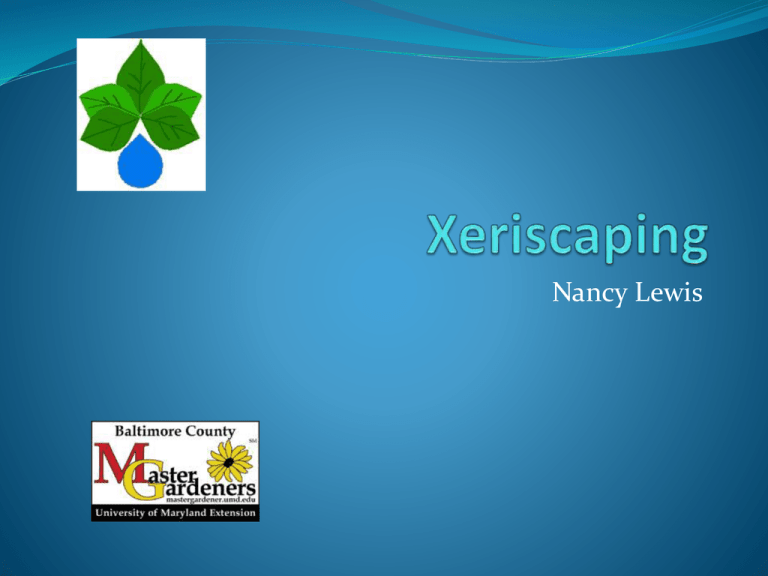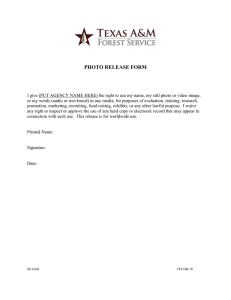Nancy Lewis
advertisement

Nancy Lewis MG Plant Sale May 9 9-2pm Why Xeriscaping? Xeriscaping Maintain a healthy landscape while reducing water usage More than plant selection - • • • • • Landscape design Soil improvements Proper irrigation Mulching Proper maintenance Advantages Lower water bills Frees up water Less time needed for maintenance Reduce energy use Reduce lawn mowing Advantages Increased habitat Beds better use and trap rainfall Utilizes water instead of runoff Water restrictions less problematic NASA photo Disadvantages More start up preparing the beds Homeowner’s association may reject nontraditional beds Mind set adjustment May require more maintenance City of Kamloops BC photo 7 steps Planning and Design Soil Preparation Appropriate Plant Selection Manage Turf Areas Efficient Irrigation CO State University photo Mulch Properly Appropriate Maintenance Planning & Design Observe the site •High use areas •Views •Wind direction •Slopes •Shade •Traffic flow Develop plan based on •Appearance •Budget •Local restrictions •Water and runoff •Photo courtesy of Denver Water Board Zonal Planting Hydrozoning Taking advantage of unique attributes – Shade Contour Aesthetics Water availability ND State University Planning and Design Before After Oasis Zone Highest water use Where time is spent Water access Easier to maintain More color Vegetables Transition Zone Moderate water use May require additional water during drought May require soaker hoses or drip irrigation Northern Gardens photo Xeric Zone Little or no supplemental water Distant from home Unremitting sunlight Under maples Soil Preparation Soil test is optimal Sandy soil holds water better with organic matter Clay will absorb better and hold runoff with organic matter 2-3” of organic matter Soil Preparation Good soil should Retain water Allow proper drainage Allow oxygen to reach the roots Soil amendments should be tilled in when planting Create practical turf areas Turf areas are high resource demand Play and walkways Mow high to save water 3-3 1/2” Do not over-fertilize Denver Water Board photo Recycle clippings Turf Areas Credit State of ME Dept of Agriculture Photo courtesy of Sprinkler Doctor Trees & Shrubs Shade Water consumption Block winds Erosion control Appropriate Maintenance Appropriate Plant Selection Xeriphytic plants Natives Silver/gray foliage Thick, glossy leaves Reduced leaf surfaces Plant Selection Color Height Like water needs Many varieties Mulch Appropriately Tree Doctor.net photo Effective Water Use Water harvesting French Drains Jim Sanders photos Roger Henthorn photo Irrigation Delivers water immediately Good for berms Good for narrow or odd sized spaces No overspray – reduces runoff and mold problems photo pgcd.net Xeric Plants for Shady Areas Epimedium Lilafee Prunus caroliniana Hellebores Echinacea pallida Stokesia laevis Mary Gregory Santa Rosa Gardens photo Hamamelis virginiana Cirrus Image photo Cornus racemosa University of Connecticut photo 2000 Hosta of the Year Liberty to Syneilesis acontifolia Narcissus Xeric plants for sunny areas Bluestone photo Sedum Postman’s Pride Physocarpus Coppertina Sedum Dragon’s Blood Achillea Fiesta Terra Cotta Bluestone photo Artemesia species o Antennaria neglecta Asclepias tuberosa Wisconsin Botany.edu photo Ohio State University.edu photo Helianthus Summer Sun Pennisetum alopecuroides Hameln Caryopteris Grand Bleu™ White Flower Farm photo Nepeta Six Hills Giant Echinacea pupurea White Swan Centaurea montana Solidago Fireworks Peter Pan Penstemon Dark Towers Bluestone photo Panicum Liatris Kobold Iris germanica Viburnum acerifoloium

